SS Lahn (1887–1904): The Immigrant’s Steamer and the Race Across the Atlantic
📌 Explore the rich archival collection of the SS Lahn at GG Archives — featuring passenger lists, menus, photographs, and more. A vital resource for teachers, students, historians, and genealogists studying Atlantic migration and steamship history.
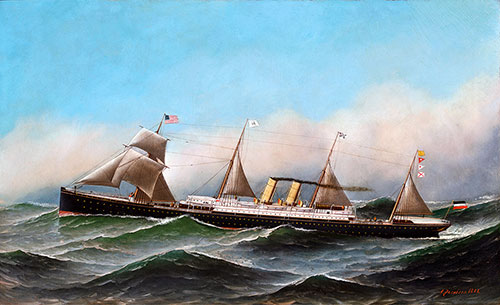
SS Lahn of the Norddeutscher Lloyd, 1888. (From a Painting by A. Jacobsen) | GGA Image ID # 20dcbbc730
🛳️ Review and Summary: SS Lahn Archival Collection — A Window into the Atlantic Migration Experience
📚 "Steamships, Society, and the Journey of Hope, 1887–1904"
🚢 Overview: Why the SS Lahn Matters
The SS Lahn archival collection at the GG Archives is a treasure trove for teachers, students, genealogists, historians, and ocean travel enthusiasts alike. Through passenger lists, menus, brochures, photographs, and ship histories, this carefully curated set vividly documents the story of a steamship that helped ferry thousands across the Atlantic during the height of European immigration to America.
The SS Lahn, launched in 1887 for the Norddeutscher Lloyd line, was among the fastest Atlantic steamers of her day — a vital thread in the great tapestry of 19th-century migration, commerce, and social transformation.
Content Links
- 🛳️ Review and Summary: SS Lahn Archival Collection
- Lahn (1887) North German Lloyd Ship's History (Brief)
- Passenger Lists
- Brochures
- Menus
- Photographs
- Sailing Schedules
- Books
- Back Cover Images
- SS Lahn - Speed Records - 1889
- Advertisements
- Steerage Accommodations on the SS Lahn
- 🎓 Educational and Research Relevance
- ✨ Engaging Highlights from the Collection
- 📸 Noteworthy Images
- 📚 Thematic Highlights Across the Collection
- 🧠 Final Thoughts: Why This Collection is a Gem
Lahn (1887) North German Lloyd
Built by Fairfield Shipbuilding & Engineering Co., Glasgow, Scotland. Tonnage: 5,681. Dimensions: 448' x 49' (464' O.I.). Propulsion: Single-screw, 18 1/2 knots. Triple expansion engines. Masts and Funnels: Four masts and two funnels. Additional Features: Iron hull. Passengers: 224 first, 106 second, 700 third. Maiden voyage: Bremen- Southampton-New York in December 1887. Note: When new was the third fastest steamship on the Atlantic. The Lahn could make the voyage between Southampton and New York in under seven days. Modifications: At later date reduced to two masts. Services: Placed in Mediterranean-New York trade at later date. Renamed: (a) Russ (1904) Russian, (b) Dniestr. Still in Russian hands as late as 1927.
Return to Content Links
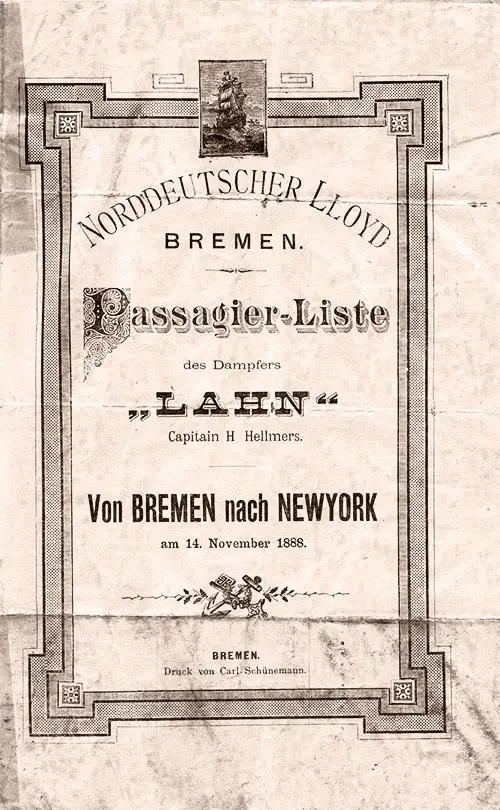
1888-11-14 SS Lahn Passenger List
SS Lahn (1888) Steerage Passenger List: A Journey of Hope from Bremen to New York
Steamship Line: North German Lloyd / Norddeutscher Lloyd
Class of Passengers: Steerage
Date of Departure: 14 November 1888
Route: Bremen to New York
Commander: Captain H. Hellmers
Note: 👤 The 14 November 1888 crossing carried hundreds of steerage passengers, most of them Eastern and Central European migrants seeking new lives in America.

1889-07-31 SS Lahn Passenger List
🎩 “Transatlantic Prestige: Society, Scholars, and Statesmen Aboard the SS Lahn”
Steamship Line: Norddeutscher Lloyd
Class of Passengers: Cabin
Date of Departure: 31 July 1889
Route: New York to Bremen via Southampton
Commander: Captain H. Hellmers
Note: This west-to-east voyage was returning elite passengers from their American excursions—ranging from society figures and diplomats to businessmen, clergy, and scientists—marking the SS Lahn as a floating salon of intellect and influence.

1894-08-28 SS Lahn Passenger List
📜 "Migration in Motion: Lives Aboard the SS Lahn from Bremen to New York"
Steamship Line: Norddeutscher Lloyd (North German Lloyd)
Class of Passengers: Steerage
Date of Departure: 28 August 1894
Route: Bremen to New York
Commander: Captain H. Hellmers
Note: The Lahn carried hundreds in steerage, many escaping political instability, poverty, and religious discrimination across Central and Eastern Europe. This voyage was no exception.

1896-08-18 SS Lahn Passenger List
🎩 "A Transatlantic Crossing of Influence: Diplomats, Clergy, Scholars, and the Gilded Elite Aboard the SS Lahn"
Steamship Line: Norddeutscher Lloyd (North German Lloyd)
Class of Passengers: Cabin
Date of Departure: 18 August 1896
Route: Bremen to New York via Southampton
Commander: Captain H. Hellmers
Note: This 1896 voyage presents a vivid snapshot of elite Atlantic migration. While many passenger lists focus on emigration or steerage class, this cabin list highlights established travelers—many of them returning from European holidays, business ventures, or intellectual tours. The diversity of nationalities and professions reflects the global influence of America’s Gilded Age and Europe’s rising bourgeoisie.
Return to Content Links
Brochures

North German Lloyd - Short Route to London - 1889
🎓 “A 19th-Century Ocean Travel Brochure Turned Educational Goldmine”
The 1889 North German Lloyd (NDL) brochure titled "The Short Route to London via Southampton and the Continent" is more than a promotional travel pamphlet—it is a remarkable cultural artifact that opens a window into late 19th-century transatlantic steamship travel. Created during the Paris Exhibition of 1889, this richly detailed guide was distributed by Oelrichs & Co., the line’s New York agents, and served as both a functional passenger handbook and a marketing showcase for NDL’s first and second cabin services.
Teachers, students, genealogists, and historians will find the brochure incredibly valuable for understanding the social, economic, and technological structures of the Gilded Age’s oceanic travel system.
Return to Content Links
Menus
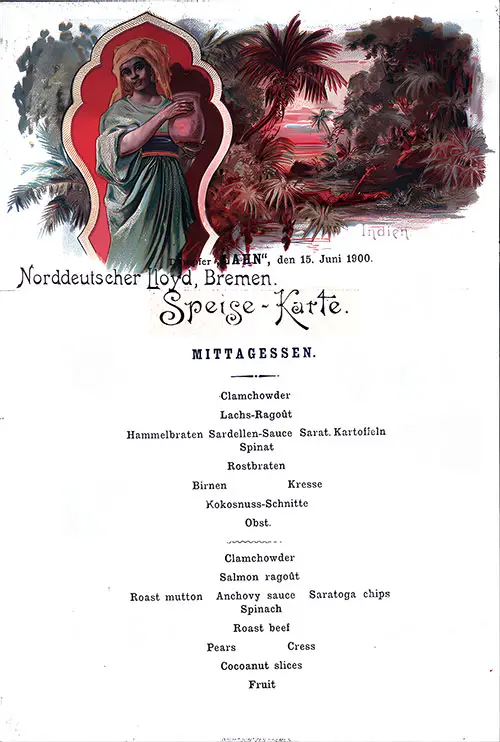
1900-06-15 SS Lahn Luncheon Menu Card
🍽️ “Dining Aboard a North German Lloyd Steamer in the Belle Époque”
This Luncheon Menu from the SS Lahn of the North German Lloyd, dated 15 June 1900, provides a succinct yet flavorful snapshot of transatlantic dining during the Edwardian era. Although the passenger class is unstated, the menu’s bilingual format (German & English), restrained yet refined dish selection, and presence of specialty sauces and fresh fruit suggest it likely belonged to the Second Cabin—a class designed for the middle-class traveler seeking quality without the extravagance of First Class.

1900-06-20 SS Lahn Luncheon Menu Card
🍽️ “Luncheon Across the Atlantic: Seafaring Simplicity Meets European Elegance”
This bilingual Luncheon Menu (German/English) from 20 June 1900, on an eastbound voyage of the SS Lahn operated by North German Lloyd, offers a well-balanced selection of classic late 19th-century fare, suited to midday appetites. Though the class is unstated, the presence of codfish with butter sauce, roast beef with French-style herb sauce, a variety of desserts, and printed bilingual formatting all suggest this menu likely served Second Cabin passengers—a tier designed for middle-class travelers who expected a respectable dining experience without First-Class opulence.
Return to Content Links
Photographs

C. Gottlieb Strube, Steerage Passenger on the SS Lahn, 14 November 1888. | GGA Image ID # 1f93ff42bd
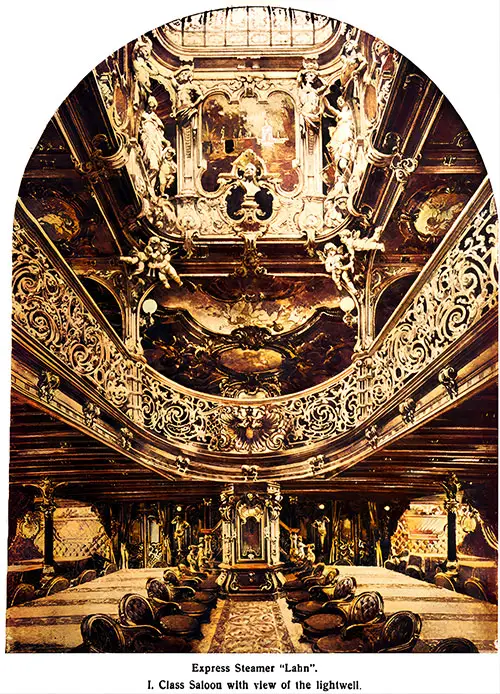
Express Steamer SS Lahn First Class Saloon with View of the Lightwell. Norddeutscher Lloyd History and Organization, 1908. | GGA Image ID # 1ddbb2d294
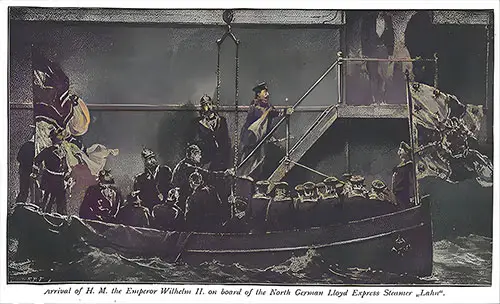
Arrival of Emperor Wilhelm II on the SS Lahn. Guide Through North and Central America, April 1898. | GGA Image ID # 1ddfd00169
Return to Content Links
Sailing Schedules
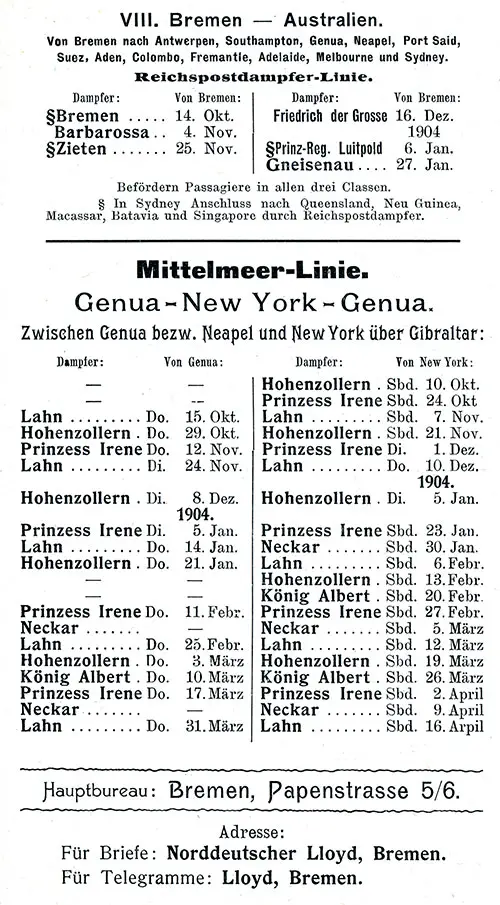
Sailing Schedule, Bremen-Australian Ports and Genoa-New York, from 14 October 1903 to 16 April 1904. Ships Included the Barbarossa, Bremen, Friedrich dr Grosse, Gneisenau, Hohenzollern, König Albert, Lahn, Neckar, Prinz Regent Luitpoid, Prinzess Irene, and Zieten. SS Kaiser Wilhelm II Cabin Passenger List, 6 October 1903. | GGA Image ID # 213715a8fe
Return to Content Links
Books Referencing the SS Lahn

Guide Through North & Central America (Norddeutscher Lloyd) - 1898
🎩 “A Grand Tour by Steamship: Exploring the Americas with North German Lloyd”
Published in April 1898 by J. Reichmann & Cantor of Berlin and New York, the Guide Through North & Central America was more than a simple travel manual. Lavishly illustrated and distributed as a souvenir for passengers aboard North German Lloyd (NDL) steamships, it provided a snapshot of late 19th-century transatlantic tourism, immigration, and shipping excellence.
Intended as a companion piece to NDL’s acclaimed European guide, this first edition introduces readers to the cultural, geographic, and infrastructural wonders of the United States (and parts of Canada and Mexico in future editions). It captured the era of grand steamship travel, a time when visiting Niagara Falls or the Grand Canyon involved weeks of planning and intercontinental coordination.
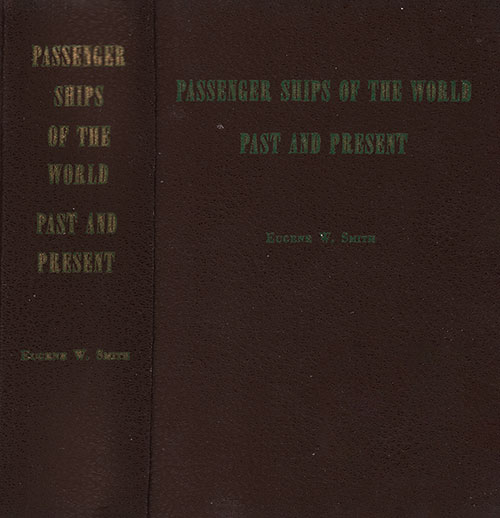
Passenger Ships of the World - 1963
🎓 “A Global Voyage Through Steamship History for Historians, Genealogists, and Maritime Enthusiasts”
Eugene W. Smith’s Passenger Ships of the World – Past and Present (1963) is a masterfully curated encyclopedic reference that charts the rise, peak, and transformation of ocean-going passenger ships through nearly two centuries. Expanding upon his earlier Trans-Atlantic and Trans-Pacific works, Smith offers a global maritime panorama that includes ships serving the Americas, Africa, Europe, Asia, Australia, and Oceania, as well as Canal routes and California-Hawaii shuttle lines.
🧭 This book is an essential resource for:
- Maritime historians seeking design evolution and fleet data
- Genealogists tracing voyages and shipping lines
- Educators and students studying transoceanic migration and tourism
- Ship modelers, naval architects, and enthusiasts interested in dimensions, tonnage, and speed

The American Line: 1871-1902 (2000)
📚 "Restoring the Stars and Stripes to the North Atlantic"
William H. Flayhart III’s The American Line: 1871–1902 is a powerful narrative chronicling one of the most ambitious yet underappreciated efforts in U.S. maritime history: the rebirth of American transatlantic shipping in the age of steam. For teachers, students, historians, genealogists, and lovers of ocean liner history, this book offers an indispensable resource on how the American Merchant Marine tried to reclaim its former glory after the Civil War devastated the industry.
The book centers around the rise of the American Line, backed by Philadelphia’s business elite and the Pennsylvania Railroad, and its close cousin, the Red Star Line, launched under a foreign flag to circumvent U.S. restrictions. Flayhart’s exhaustive research delivers a sweeping yet accessible account of how these two lines changed the face of transatlantic travel.

Transatlantic and the Great Atlantic Steamships
📚 "Steam, Vision, and the Race to Master the Atlantic"
Stephen Fox’s Transatlantic offers a sweeping and exhilarating history of the steamship's golden age and the titans who built it. Centered around Samuel Cunard and Isambard Kingdom Brunel, this book isn't just about the technological evolution of ships — it’s a deep exploration of commerce, engineering ambition, immigration, and the transformation of the Atlantic world during the 19th century.
For teachers, students, genealogists, and historians, Transatlantic provides an engaging, richly detailed window into the transition from sail to steam, as well as the intense competition among Britain, Germany, and the United States to dominate the most important oceanic highway on earth.
Return to Content Links
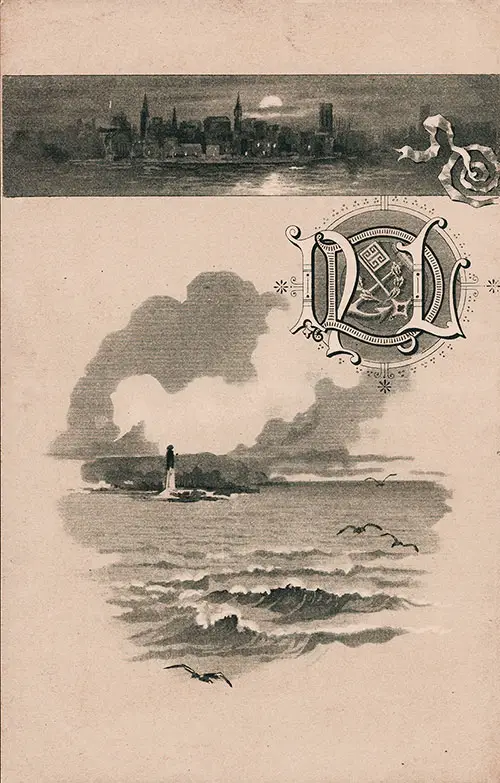
Back Cover, North German Lloyd SS Lahn Cabin Passenger List - 31 July 1889. | GGA Image ID # 1f93f370f4

Back Cover of 1889 Brochure from North German Lloyd "Short Route to London via Southampton and the Continent." GGA Image ID # 11f5b2f249
Return to Content Links
SS Lahn - Speed Records - 1889
THE " LAHN."
The North German Lloyd steamship Lahn surprised and delighted her friends and admirers by making a remarkably quick trip from Southampton to New York. She passed the Needles at 5.30 P. M., August 22d, and the corrected time of her passage was 6 days, 22 hours and 40 minutes, or within 1 hour and 17 minutes of the best time ever made. Her average speed was 18.36 knots per hour.
Source: Ocean: Magazine of Travel, Vol. III, No. 2, September 1889, Page 41
Return to Content Links
Advertisements
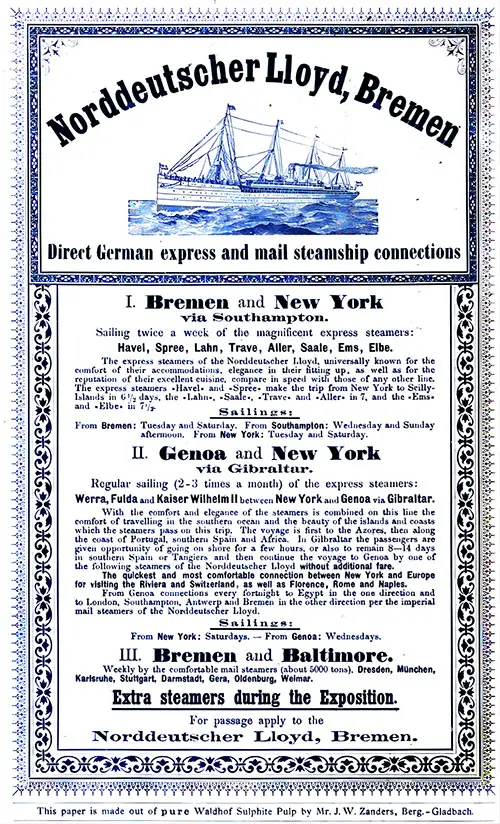
Advertisement (1893): Norddeutscher Lloyd German Express Mail Steamship Connections Promoting the 1893 World's Columbian Exposition in Chicago. | GGA Image ID # 227ffc1844
I. Bremen and New York via Southampton.
Sailing twice a week of the magnificent express steamers: Havel, Spree, Lahn, Trave, Aller, Saale, Ems, Elbe.
The express steamers of die Norddeutscher Lloyd, universally known for die comfort of their accommodations, elegance in their fitting up. as well as for die reputation of their excellent cuisine, compare in speed with those of any other line. The express steamers - Havel- and - Spree- make the trip from New York to Scilly Islands in 6½ days, the -Lahn-, - Saale-, -Trave- and - Aller- in 7 days, and the -Ems- and -Elbe- in 7½ days. Sailings: From Bremen: Tuesday and Saturday. From Southampton: Wednesday and Sunday afternoon. From New York: Tuesday and Saturday.
II. Genoa and New York via Gibraltar.
Regular sailing (2-3 times a mouth) of the express steamers: Werra, Fulda and Kaiser Wilhelm II between New York and Genoa via Gibraltar.
With the comfort and elegance of the steamers is combined on this line the comfort of travelling in the southern ocean and the beauty of the islands and coasts which the steamers pass on this trip. The voyage is first to the Azores, then along the coast of Portugal. southern Spain and Africa. In Gibraltar the passengers are given opportunity of going on shore for a few hours, or also to remain 8—14 days in southern Spain or Tangiers and then continue the voyage to Genoa by one of the following steamers of the Norddeutscher Lloyd without additional fare.
The quickest and most comfortable connection between New York and Europe for visiting the Riviera and Switzerland, as well as Florence, Rome and Naples.
From Genoa connections every fortnight to Egypt in the one direction and to London, Southampton. Antwerp and Bremen in the other direction per the imperial mail steamers of the Norddeutscher Lloyd.
Sailings: From New York: Saturdays. — From Genoa: Wednesdays.
III. Bremen and Baltimore.
Weekly by the comfortable mad steamers (about 5000 tons).
Dresden, München, Karlsruhe, Stuttgart Darmstadt Gera, Oldenburg, Weimar.
Extra steamers during the Exposition.
For passage apply to the Norddeutscher Lloyd, Bremen.
Steerage Accommodations on the SS Lahn
1. Introduction
The latter half of the 19th century witnessed a monumental surge of European emigration to the United States, a phenomenon of profound historical significance. This mass movement was propelled by a complex interplay of socio-economic factors on both sides of the Atlantic, shaping the course of history.[1]
Steamships, a marvel of technological advancement, played a pivotal role in democratizing transatlantic travel. Compared to their sailing predecessors, their faster and more reliable mode of transportation made the dream of a new life in America more accessible to a broader population, reshaping the course of history.[3]
Among the prominent shipping companies that dominated this era was the Norddeutscher Lloyd (NDL). This German enterprise became a key player in transatlantic passenger services.[5] The SS Lahn, a vessel operated by NDL in 1894, was part of this vast network connecting Europe with the promise of a new life in America.
Understanding the conditions within its steerage accommodations is vital to comprehending the realities most of these emigrants face during their arduous journey. Examining these passengers' physical environment, daily life, and treatment provides a crucial lens through which to view this significant period of global migration.
2. The SS Lahn: A Historical Context
2.1 Norddeutscher Lloyd (NDL): A Shipping Giant
Established in the mid-19th century, the Norddeutscher Lloyd rapidly evolved into one of the most significant German shipping companies, playing an instrumental role in the economic development of Bremen and Bremerhaven.[5]
Its strategic emphasis on building fast liners under the direction of Johann Georg Lohmann contributed to its prominence in the competitive transatlantic market.[5]
By the late 19th and early 20th centuries, NDL had amassed an extensive fleet and operated numerous routes, with transatlantic passenger services to North and South America forming a crucial part of its operations.[5]
The company's dominance in steerage traffic, particularly the transport of immigrants to New York, made it a central figure in the history of European migration.[5]
NDL's long-standing presence in the shipping industry concluded in 1970 when it merged with the Hamburg America Line (HAPAG) to form Hapag-Lloyd AG.[5]
This merger marked the culmination of decades of operation and solidified NDL's historical importance in global shipping.
2.2 The SS Lahn: Construction and Service History
The SS Lahn was constructed in 1887 by the Fairfield Shipbuilding & Engineering Company in Glasgow, Scotland, indicating the international nature of shipbuilding and the adoption of contemporary British engineering standards by NDL.[10]
The vessel possessed key specifications, including a tonnage of approximately 5,681 gross tons and dimensions of 464 feet in length and 49 feet in beam.[10]
Powered by a steam triple expansion engine and equipped with a single screw, the SS Lahn was capable of a service speed of around 18.5 knots, enabling relatively swift transatlantic crossings for the era.[10]
The ship embarked on its maiden voyage in February 1888, sailing from Bremen to Southampton and then onwards to New York, establishing its primary route along a significant transatlantic corridor for immigration.[12]
Evidence confirms that SS Lahn was actively engaged in this service in 1894, as indicated by a steerage passenger list dated August 28, 1894, documenting a voyage from Bremen to New York.[15] Beyond its North Atlantic service, the SS Lahn also operated on routes to Australia and the Mediterranean, showcasing its versatility within NDL's global network.[10]
The vessel's service life eventually concluded with its sale to the Russian Navy in 1904 and subsequent scrapping in 1927, placing its operational period within a defined historical context.[10]
2.3 Passenger Capacity and Class Structure
The SS Lahn had a total passenger capacity of 1,030 individuals, reflecting the large scale of transatlantic migration at the time.[10] This capacity was divided into distinct classes, indicative of the social hierarchies prevalent during the late 19th century and the varying comfort levels afforded based on the ticket price.[18]
The breakdown included 224 passengers in first class, 106 in second class, and a significant 700 in third class, also known as steerage.[10] The fact that nearly 70% of the SS Lahn's passenger capacity was dedicated to steerage underscores its primary role in transporting immigrants across the Atlantic.
This large number of steerage passengers would have profoundly shaped the conditions and experiences within their designated areas of the ship. The clear demarcation of passenger classes highlights the stark contrast in travel experiences based on economic means and social standing.
3. The Steerage Compartments: Physical Layout
3.1 Location on the Ship
Steerage accommodations on steamships like the SS Lahn in the late 19th century were typically located on the vessel's lower decks, often towards the bow.[13] These spaces were sometimes converted cargo holds or were purpose-built but extremely basic areas designed to maximize the number of passengers at the lowest cost.[18]
The placement in the lower parts of the ship meant that steerage passengers were more susceptible to the vessel's movements, experiencing greater motion and noise, and had limited access to natural light and fresh air, all contributing to discomfort and seasickness.[18]
Rivers-class liners, the type to which the SS Lahn belonged, often designated the third deck specifically for steerage passengers.[13] This suggests that a substantial portion of the SS Lahn was allocated to accommodate the 700 steerage passengers, indicating a large section of the ship dedicated to their basic needs.
3.2 Sleeping Quarters
The sleeping quarters in steerage were typically large, open compartments designed to accommodate many passengers, sometimes as many as 300 or more in a single space.[24]
Within these compartments, rows of simple, iron-framed berths were stacked two or three high, with minimal space between each bunk.[20] This arrangement afforded minimal privacy, with passengers sleeping near each other, often strangers.[22]
Recognizing the need for some level of separation, shipping companies usually provided separate compartments for single women, single men, and families.[24] While this segregation aimed to offer a degree of protection and privacy, particularly for unaccompanied women, it could also lead to the separation of families or create logistical complexities in managing such large numbers of people.
The sheer density of passengers in these sleeping quarters would have resulted in significant overcrowding, constant noise, and a profound lack of personal space, severely impacting the overall experience for those traveling in steerage.
3.3 Dining and Social Areas
While earlier in the history of transatlantic travel, steerage passengers often ate and spent their time within their sleeping compartments, some improvements were being made by the late 19th century.[1]
Steerage accommodations on some ships began to include separate dining rooms, offering a dedicated space for meals.[1] The fact that menus from the SS Lahn existed from around the turn of the century [25] strongly suggests that by 1894, the ship likely had dedicated dining arrangements for steerage passengers.
This would indicate a more organized system for managing the daily needs of many third-class travelers compared to earlier periods. However, most vessels had limited open deck space available to steerage passengers.[24]
This restriction meant that opportunities for fresh air and exercise were scarce, further contributing to the sense of confinement experienced below deck. The lack of ample social areas would also limit the interaction and recreation of steerage passengers during the long voyage.
3.4 Sanitation Facilities
Sanitation facilities in steerage were typically basic and often insufficient for the many passengers they intended to serve.[20] The number of toilets and washbasins available was frequently inadequate, leading to overcrowding and unhygienic conditions within these spaces.[20]
These facilities were sometimes located on the deck, making them inaccessible during bad weather or rough seas when passengers were confined below.[26] This inaccessibility would have significantly exacerbated the discomfort and unsanitary conditions in steerage, potentially forcing passengers to resort to makeshift arrangements within their sleeping quarters.
The generally poor state of sanitation contributed to the spread of disease and unpleasant odors throughout the steerage compartments, making hygiene a constant challenge for the passengers.
4. Life in Steerage: Conditions and Provisions
4.1 Sleeping Arrangements and Comfort
The sleeping arrangements in steerage on the SS Lahn in 1894, consistent with the general standards of the time, offered minimal comfort. Mattresses were typically filled with straw or seaweed, often thin materials that provided little support for a transatlantic journey lasting several days or weeks.[22]
The bedding was also minimal, with blankets sometimes inadequate to provide sufficient warmth, especially during colder months or rough seas.[24] Passengers had minimal personal space within their berths, which also had to serve as storage for their meager belongings.[24]
Furthermore, the berths received no attention from the ship's stewards during the voyage.[24] This lack of cleaning or maintenance meant that the hygiene of the sleeping quarters was primarily left to the passengers themselves, who had limited resources and means to address it effectively.
The overall experience of sleeping in steerage would have been characterized by physical discomfort, lack of privacy, and challenges in maintaining basic hygiene.
4.2 Hygiene and Sanitation Practices
Maintaining personal hygiene in steerage on the SS Lahn in 1894 would have been a significant challenge. The primary means of washing was cold salt water, with warm water being either very limited or unavailable.[24]
This would have made even basic cleaning unpleasant and ineffective, particularly in colder climates. Passengers were generally required to provide their soap and towels, adding a financial burden to those already impoverished and potentially limiting their ability to maintain proper hygiene if they could not afford or carry these items.[24]
The washrooms and toilets in steerage were often damp and filthy, especially on the days leading up to the final day of the voyage when a thorough cleaning was typically done in preparation for inspection at the port of entry.[24]
This suggests that the usual conditions were far from sanitary, creating a breeding ground for disease and contributing to the overall squalor of the steerage environment. The limited number and poor sanitation facilities would have made it difficult for passengers to maintain basic cleanliness.
4.3 Food and Water Provisions
Unlike earlier periods when steerage passengers were often expected to bring their food for the transatlantic voyage, by 1894, Norddeutscher Lloyd generally provided rations to those traveling in steerage.[1]
The existence of menus from the SS Lahn dating around 1901 [25] suggests that a basic but structured meal service was likely in place even in 1894. These menus indicate that steerage passengers received regular meals, including breakfast, dinner, and tea, offering a degree of sustenance during the journey.
However, the general quality of food served in steerage on transatlantic voyages during this period was often described as poor and sometimes barely edible on other ships.[1] While NDL provided food, it is reasonable to assume that the meals on the SS Lahn were basic, likely lacking in nutritional value and taste compared to the provisions for first and second-class passengers.
Passengers might have also been required to bring their eating utensils, adding another layer of inconvenience.[23] Access to a sufficient supply of fresh water was also a critical concern on long voyages, and limitations in the available drinking water could have posed a significant challenge to the health and well-being of steerage passengers.[23]
4.4 Ventilation, Light, and Air Quality
Ventilation in the steerage compartments of the SS Lahn in 1894 was likely poor, a common issue on transatlantic steamships of the era.[20] This problem was particularly acute during storms or rough seas when the ship's hatches were closed to prevent water from entering the lower decks.[20]
The lack of fresh air in the overcrowded compartments would have created stifling and unhealthy conditions, exacerbating issues like seasickness and the spread of disease.[20] The air quality in steerage was often described as foul and stale, filled with the odors of unwashed bodies, seasickness, and waste, making the environment highly unpleasant and potentially contributing to respiratory problems.[20]
Natural light in the lower decks was also limited, making the already cramped and crowded conditions feel even more oppressive and potentially affecting the psychological well-being of passengers during the long journey.[22]
5. Treatment and Regulations
5.1 Interaction with the Crew
The social hierarchy prevalent on board transatlantic steamships in 1894 often placed steerage passengers at the bottom, and their interactions with the crew could be characterized by indifference or even contempt.[18] This likely mirrored the societal norms of the time, where poor immigrants were often regarded with less respect than those in higher social and economic classes.
While specific accounts of mistreatment on the SS Lahn in 1894 are not readily available in the provided snippets, reports from other ships of the era suggest that abuse and exploitation of steerage passengers did occur.[1] Due to their vulnerable position and limited ability to voice complaints or seek redress, steerage passengers were potentially susceptible to such treatment.
The crew's primary focus would likely have been on the needs and comfort of the first and second-class passengers, with many steerage passengers perhaps viewed more as cargo than individuals requiring considerate attention.
5.2 Regulatory Framework
Recognizing the often inhumane conditions in steerage, the United States government enacted several Steerage Acts throughout the 19th century to improve transatlantic travel standards.[26]
The Acts of 1819 and 1855, in particular, sought to establish minimum requirements for space per passenger, the quality and quantity of food and water provisions, and basic sanitation on vessels arriving in American ports.[26]
These regulations evolved with increasing demands for better ventilation, improved medical facilities, and a greater overall focus on the health and safety of steerage passengers.[20]
As a major shipping line operating routes to the United States, the Norddeutscher Lloyd and its vessels, including the SS Lahn, would have been subject to these US regulations.[5]
Therefore, the conditions in steerage on the SS Lahn in 1894 likely reflected the prevailing legal standards and requirements set forth by American law, representing an improvement over the often-appalling conditions reported in earlier decades before such regulations were in place or effectively enforced.
5.3 Norddeutscher Lloyd's Policies
Norddeutscher Lloyd's dominance in the steerage traffic of the late 19th century suggests that the company had established specific policies and systems for managing the large numbers of immigrants they transported.[5] This likely included procedures for boarding, assigning accommodations, distributing food, and addressing basic health concerns during the voyage.
The fact that menus from the SS Lahn exist from around 1901 [25] indicates a company policy of providing meals to steerage passengers by this time, a practice that was not universally adopted by all shipping lines throughout the 19th century.
This suggests that NDL took some responsibility for sustaining its third-class travelers. While detailed documentation of NDL's specific regulations concerning the treatment of steerage passengers in 1894 is not readily available in the provided snippets, the company's need to comply with US law and its established role in the immigrant trade would have necessitated some level of internal guidelines and procedures for managing this significant portion of their passenger business.
6. The Steerage Passengers: Who Were They?
6.1 Motivations for Travel
Most steerage passengers on ships like the SS Lahn in 1894 were European immigrants whose primary motivation for undertaking the arduous transatlantic journey was the pursuit of economic opportunities and a chance for a better life in the United States.[1]
Many were escaping poverty, famine (such as the historical context of the Irish Potato Famine mentioned in the snippets [18]), political or social unrest, and limited prospects in their homelands.[3]
The dire circumstances they faced in Europe often left them with little alternative but to seek a new beginning across the Atlantic, making them willing to endure the harsh realities of steerage travel as a necessary step towards achieving their hopes for a more prosperous future.
6.2 Nationalities and Origins
As a German shipping company, Norddeutscher Lloyd likely carried many German emigrants among its steerage passengers.[37] However, transatlantic migration in the late 19th century involved people from various European countries, all seeking opportunities in America.[1]
Therefore, while Germans would have likely formed a substantial group on the SS Lahn, the ship would have also transported individuals and families from other nations across Europe who were similarly motivated to immigrate to the United States.
The steerage passenger list from August 28, 1894 [15], while not providing the nationality of every passenger in these snippets, serves as direct evidence of the diverse group of individuals undertaking this journey on the SS Lahn.
6.3 Social and Economic Backgrounds
The steerage passengers on the SS Lahn in 1894 predominantly came from European society's lower social and economic strata, possessing limited financial resources.[1] Despite its challenging conditions, the relative affordability of steerage passage made it the only viable option for those with limited means to travel to America, highlighting the stark economic disparities in transatlantic travel.
Common occupations among these emigrants included agricultural laborers, unskilled workers seeking industrial jobs, and artisans whose traditional trades were declining due to industrialization in Europe.[37]
Migration was often a family endeavor, with entire families traveling with the shared aspiration of building a new and better life in the United States.[21] The steerage experience, therefore, was endured collectively by individuals and families united by their hopes for a brighter future in a new land.
7. Visual Documentation of the SS Lahn's Steerage
7.1 Availability of Specific Images
The provided research snippets do not contain direct images or illustrations specifically depicting the steerage accommodations on board the SS Lahn in 1894. This lack of specific visual documentation makes it difficult to accurately picture the conditions within the steerage compartments of this particular vessel at that time.
Consequently, understanding the physical layout and environment of steerage on the SS Lahn in 1894 must rely on general descriptions of steerage conditions on similar ships of the era and any relevant textual details available.
However, the existence of a steerage passenger list from August 28, 1894 [15], while not visual, serves as concrete evidence of steerage travel on the SS Lahn during the year in question and potentially offers names for further research into individual passenger experiences, if such records are accessible, additionally, menus from the SS Lahn, dating around 1901 [25], provide tangible information about the ship's services, particularly the provision of food, which would have been a significant aspect of the steerage experience, even if these menus are from a slightly later period.
7.2 General Depictions of Steerage on Norddeutscher Lloyd and Contemporary Ships
While specific images of the SS Lahn's steerage in 1894 are elusive in the provided material, resources like Alamy show historical photographs of Norddeutscher Lloyd ships and steerage conditions on other German vessels, such as the Friedrich der Grosse.[39]
These general depictions can offer a visual understanding of the typical layout, the level of crowding, and the fundamental nature of steerage accommodations on German steamships during the late 19th century.
The Heritage Ships website also has a category dedicated to NDL steerage passengers [42], which might contain relevant images and warrants further exploration for potential visual documentation.
Furthermore, Wikipedia's mention that the third deck of Rivers-class liners, to which the SS Lahn belonged, was typically used for steerage passengers [13] provides useful information for visualizing the location of these accommodations within the ship's overall structure.
While these general depictions are not specific to the SS Lahn in 1894, they can serve as valuable proxies for understanding the likely conditions experienced by steerage passengers on this vessel during that period.
8. Conclusion
Based on available historical information and a general understanding of transatlantic travel conditions for immigrants during this era, the steerage accommodations on board the SS Lahn in 1894 were characterized by basic and often harsh conditions.
Located on the lower decks, the steerage compartments were large, open spaces with rows of tiered berths offering minimal privacy and comfort. Sanitation facilities were rudimentary and often inadequate, contributing to unhygienic conditions.
While Norddeutscher Lloyd likely provided basic rations to steerage passengers, the food quality was probably poor. Ventilation and air quality were also significant challenges, especially during inclement weather when passengers were confined below deck.
Despite these difficult circumstances, the steerage passengers, primarily European immigrants, were driven by the hope of economic opportunity and a better life in the United States.
The SS Lahn, with its large steerage capacity, played a significant role in the mass migration across the Atlantic. The experiences of its third-class passengers reflect the broader phenomenon of transatlantic migration and the hardships endured by those seeking a new beginning in America. Understanding the conditions in steerage provides a crucial perspective on the social and historical significance of this pivotal period in global migration.
End Notes
- European Migrants' Crossings to the United States (1880-1925) - EHNE, accessed April 15, 2025.
- Oceanic Travel Conditions and American Immigration, 1890-1914, Unimuenchen accessed April 15, 2025. [PDF]
- Departure and Arrival - Europeana, accessed April 15, 2025
- Time on the Crossing: Emigrant Voyages across the Atlantic, 1853 to 1913 - IZA - Institute of Labor Economics, accessed April 15, 2025 [PDF]
- Norddeutscher Lloyd - Wikipedia, accessed April 15, 2025
- Norddeutscher Lloyd - Wikiwand, accessed April 15, 2025
- Norddeutscher Lloyd - Wikipedia(DE), accessed April 15, 2025
- RARE Cabinet Photo - SS Aller Norddeutscher Lloyd Ship Interior Salon c1880s | eBay, accessed April 15, 2025 (Ephemeral Link: Interior Scene Aller - Norddeutscher Lloyd - Bremenhaven - Salon by Louis Koch, Bremen ca. 1880s)
- North German Lloyd - Norddeutscher Lloyd - Sailing Schedule TimetableImages, accessed April 15, 2025
- The Ships They Came On - Genealogy Journey, accessed April 15, 2025
- Ships - RootsWeb, [The Ships of Our Ancestors], accessed April 15, 2025
- Antonio Nicolo Gasparo Jacobsen (American, 1850-1921), 1888 The North German Lloyd passenger ship S.S. Lahn 22 x 36 in. (56 x 91.5 cm.) - Bonhams, accessed April 15, 2025
- Rivers-class ocean liner - Wikipedia, accessed April 15, 2025
- Passenger Ships - La Famiglia Girimonti!, accessed April 15, 2025
- SS Lahn Passenger List - 28 August 1894 - Pinterest [GG Archives], accessed April 15, 2025
- SS Lahn Passenger List - 28 August 1894 - Pinterest [GG Archives], accessed April 15, 2025
- Trans-Atlantic passenger ships, past and present - The Trades House Digital Library, accessed April 15, 2025 [PDF]
- Life On Board - Passengers - Steamship Historical Society of America, [SOCIAL STUDIES – Find out the similarities and differences among the classes traveling on steamships in Life On Board – Passengers.] accessed April 15, 2025
- Steamboat Experience and Environment - Oklahoma Historical Society, accessed April 15, 2025
- In the Steerage of the Great Atlantic Migration - New York Almanack, accessed April 15, 2025
- The Journey to America, Devlin Family, accessed April 15, 2025
- Steerage - Wikipedia, accessed April 15, 2025
- Steerage-passenger conditions in the 1880s - Dawlish Chronicles, accessed April 15, 2025
- The Steerage Experience - RootsWeb [Greg Krenzelok], accessed April 15, 2025
- Life on a Sailing Ship in the Early 1800's, Duchesne-hs.org accessed April 15, 2025 [PDF]
- America's First Immigration Law Tried (and Failed) to Deal With Nightmarish Sea Journeys, History.com, accessed April 15, 2025
- America's First Immigration Law Tried (and Failed) to Deal With Nightmarish Sea Journeys, History.com, accessed April 15, 2025
- Ship Travel - Windhill Origins, accessed April 15, 2025
- Immigration - Steamship Historical Society of America, accessed April 15, 2025
- BREAKFAST [held by] NORDDEUTSCHER LLOYD - BREMEN [at] "EN ROUTE - SS ""LAHN""" (SS) - NYPL Digital Collections, accessed April 15, 2025
- BREAKFAST [held by] NORDEUTSCHER LLOYD - BREMEN [at] "EN ROUTE - SS ""LAHN""" (SS) - NYPL Digital Public Domain Collections, accessed April 15, 2025
- LUNCH [held by] NORDDEUTSCHER LLOYD BREMEN [at] EN, GetArchive.net, accessed April 15, 2025
- DINNER [held by] NORDDEUTSCHER LLOYD [at] EN ROUTE, NYPL GetArchive.net, accessed April 15, 2025
- Overview + History | Ellis Island, StatueOfLiberty.org, accessed April 15, 2025
- The Steerage Experience - The Only Way to Cross - Ocean Liners Blog @ WordPress.com, accessed April 15, 2025
- What was life like on board a ship for our emigrant ancestors generations ago? - Findmypast, accessed April 15, 2025
- Norddeutscher Lloyd and Baltimore - Loyolanotredamelib, accessed April 15, 2025 [PDF]
- U.S. Passenger Lists - Ancestry, accessed April 15, 2025
- Ship 19th century lloyd hi-res stock photography and images - Alamy, accessed April 15, 2025
- Steerage Black and White Stock Photos & Images - Alamy, accessed April 15, 2025
- Ship 19th century lloyd Black and White Stock Photos & Images - Alamy, accessed April 15, 2025
- Steerage passengers - Heritage Ships, accessed April 15, 2025
🎓 Educational and Research Relevance
Teachers & Students: Perfect for lessons on immigration history, industrial innovation, and social class distinctions at sea.
Genealogists: Passenger lists (both steerage and cabin) offer rare, detailed snapshots of individuals and families who risked everything to begin anew.
Historians: The archival material illustrates the broader context of Atlantic competition, maritime labor, steerage reforms, and the impact of technology on society.
Ocean Travel Enthusiasts: Authentic menus, speed records, and ship specifications make this a goldmine for understanding the luxury, hardships, and aspirations aboard late-19th-century liners.
✨ Engaging Highlights from the Collection
🧳 Passenger Lists: Journeys of Dreams and Influence
📜 Steerage Lists (1888, 1894) tell the story of ordinary migrants, many fleeing hardship.
📜 Cabin Lists (1889, 1896) reveal society figures, diplomats, and scholars returning from American tours, showcasing the SS Lahn as a floating microcosm of late Victorian and Gilded Age society.
🍽️ Menus: A Taste of Life Afloat
📜 Luncheon menus from June 1900 show simple yet refined meals—likely for Second Cabin passengers—highlighting the changing expectations of ocean travelers at the turn of the century.
📚 Brochures and Guides: Marketing the Atlantic Experience
📜 The Short Route to London brochure (1889) beautifully illustrates the marketing genius behind steamship travel — emphasizing speed, luxury, and convenience.
🎨 Photographs: Visualizing Life Aboard
🖼 Painting of the SS Lahn (A. Jacobsen, 1888): Romanticizes the vessel’s sleek profile at sea.
🖼 First Class Saloon: A testament to luxury at sea, showcasing skylights and ornate interiors.
🖼 Arrival of Emperor Wilhelm II: Highlights the vessel’s prestige and political significance.
🚀 Speed Records and Engineering Excellence
In 1889, the Lahn nearly shattered speed records, showcasing Norddeutscher Lloyd’s technical prowess and the fierce competition to master the Atlantic crossing.
📸 Noteworthy Images
🖼 SS Lahn painting by A. Jacobsen (1888) — evokes the maritime romance and power of the great express steamers.
🖼 Steerage Passenger C. Gottlieb Strube — personalizes the anonymous mass migration.
🖼 First-Class Saloon Interior — a glimpse into the elegance afforded to wealthy travelers.
🖼 Emperor Wilhelm II's Arrival — illustrating the Lahn’s role beyond immigration in international relations.
📚 Thematic Highlights Across the Collection
Steerage Experience: Newly compiled historical research provides a sobering view of life below deck: overcrowding, poor sanitation, limited ventilation, but also resilience and hope.
Class and Comfort: First and Second Cabin accommodations reveal the vast economic divides even aboard a single vessel.
Innovation and Competition: The Lahn’s record-breaking speed and its ultimate fate illustrate the rapid technological evolution of ocean liners.
Migration Storytelling: Passenger lists and photographs humanize the millions who crossed oceans in search of a better life.
🧠 Final Thoughts: Why This Collection is a Gem
The SS Lahn archival collection doesn't just document a ship — it tells the human story of an era: the engineers who built the ships, the migrants who endured steerage for dreams of freedom, and the elite who traveled in gilded comfort. It paints a layered, rich portrait of transatlantic travel in the twilight of the 19th century.
🧳 Whether you're researching ancestors, teaching about migration, studying the evolution of maritime technology, or simply fascinated by the drama of ocean travel, this collection is an indispensable resource.
📚 Students and researchers are encouraged to dive deeper using the extensive resources at the GG Archives — perfect for essays, genealogy projects, and historical research papers! 🌊🛳️🎓
